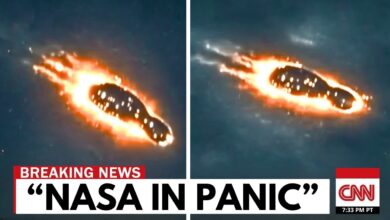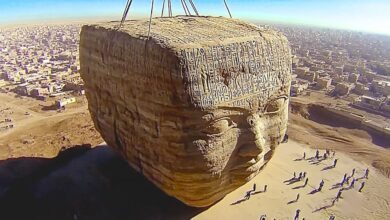Elon Musk: “I Show You The Original World Map They Didn’t Want You to See!”

**Exploring Ancient Maps and the Lost Civilization Theory:**
The passage begins with an introduction to an ancient map that may show the world from the last ice age, with coastlines and continents that we would not expect to see on such ancient maps. Among them is Antarctica, shown not as the icy land we know today, but as a land that may have once been lush and habitable. This raises the question: was there a civilization that was advanced enough to map the world with such precision thousands of years ago?
**Elon Musk and his curiosity about humanity’s lost history:**
Elon Musk has also shown a particular interest in these maps, raising the question of whether we may have lost an important part of human history. Musk’s question raises the idea of an advanced civilization that existed long ago, knew how to sail and map the world, but all of this knowledge is absent from today’s history books.
**Joe Rogan and Graham Hancock Discussion:**
Joe Rogan discussed ancient civilizations and mysterious maps with researcher Graham Hancock on his podcast. Hancock suggested that the Polynesians, who were famous for their long-distance seafaring abilities around 3,000 to 3,500 years ago, may not have been the first to make oceanic voyages. He suggested that humans may have begun to cross oceans during the last ice age.
**Genetic Evidence and Ancient Maps:**
Hancock points to DNA evidence from South America that suggests there may have been contact between peoples across oceans long ago. This has led to the hypothesis that a global civilization once existed, with a superior knowledge of the oceans and maps. Ancient maps such as the Piri Reis map, drawn in 1513, are a prime example. This map accurately depicts the coastlines of South America, North America and Africa, despite many areas being unexplored at the time.
**The Surprising Longitude Calculation on Ancient Maps:**
The Piri Reis map and several others show a surprising accuracy in longitude, which was thought to be unattainable at the time due to the lack of precise timekeeping technology at sea. This raises the question: how could ancient people have calculated longitude so accurately? Hancock suggests that this may be a sign that an advanced civilization existed long ago, with the ability to calculate precise geographical positions.
**Antarctica on Old Maps:**
Another notable feature is the presence of Antarctica on old maps before 1819 (the year it was officially discovered). Not only that, Antarctica on these maps is also shown as an ice-free land, suggesting that it may have been habitable during the ice age.
**Bimini Road and underwater structures:**
Hancock also mentions the Bimini Road – an underwater structure in the Bahamas that he believes may be the remains of an ancient man-made structure. Interestingly, the Bimini Road appears on some old maps, seemingly implying that it was above water during the ice age when sea levels were lower.
**The Lost Civilization Theory and the Cycle of Humanity:**
Finally, Hancock develops the idea of a lost civilization, possibly existing during the ice age, possibly destroyed by natural disasters. He compares it to the legend of Atlantis and suggests that, like Atlantis, these civilizations left behind small ruins, but enough for us to realize that we may not fully understand the human past.
Explore a new approach to human history, with Elon Musk and Graham Hancock, two figures known for their different perspectives on understanding and studying the past. According to them, history is not a straight line of progress but a cycle. Ancient civilizations may have achieved very high levels of technology and knowledge, but then were destroyed by natural disasters, climate change, or other catastrophic events. They ask the big question: If these ancient civilizations existed, why do we know so little about them? And why are there so few traces of these civilizations even though they built great structures, knew how to navigate the oceans, and even had the ability to measure longitude?
Graham Hancock argues that the reason we don’t find much evidence of ancient civilizations is because of time. Monuments, cities, and structures have been destroyed or erased by nature over thousands of years. Perishable items like wood and cloth have been completely lost, leaving behind only the most durable ones like stone structures and pieces of maps. Musk agrees that we may not be able to find definitive evidence from the past, but he believes that important discoveries can still be made if we keep looking. Musk believes that there may still be unexplored areas, relics buried under sediment or on the ocean floor. Musk sees these areas not as obstacles but as opportunities, and he believes that we can rediscover ancient knowledge and use it to develop the future.
One of the prominent ideas in the passage is underwater archaeology. Musk suggests that the ocean may hold the most secrets about lost civilizations. At the end of the Ice Age, sea levels were much lower than they are today, causing many ancient coastlines to sink into the ocean. Ancient cities, ports, and monuments may now lie beneath the sea, preserved like “time capsules.” Hancock notes that we have only explored so little of the ocean, so Musk and he both believe that the seas may be where the most important evidence of human history lies.
Also important to these explorations is the strangeness of Antarctica, which appears on many ancient maps. Musk is particularly interested in the idea that ancient ruins, such as cities buried thousands of years ago, may exist beneath the thick ice of Antarctica. Some studies have shown that there may be ancient rivers and lakes beneath the ice, so it is not impossible that civilizations existed there long ago.
Musk is not just seeking ancient knowledge for the sake of exploration, but he believes that what we learn from the past could be very important for building the future. Although he is a tech billionaire with a vision for the future, particularly in building settlements on Mars, developing sustainable energy, and revolutionizing transportation, Musk also recognizes that sometimes knowledge comes not from new inventions but from rediscovering what has been lost. In his eyes, ancient history is not just “old facts” but a treasure trove of ideas that can inspire the next great step in human progress.
Ultimately, Musk believes that this exploration is not just about looking back, but also connecting to the long human story of explorers, inventors, and dreamers. Understanding what has come before us can help us navigate what will come in the future. The secrets hidden in ancient maps may not just be historical relics, but rather guides to what is possible when humans dare to push the boundaries of the known world.
Musk, Hancock, and Joe Rogan have been encouraging people to rethink what we’ve been taught about history, to not just accept what we know, but to question, dig deeper, and be open to the possibility that there may be more to the historical narrative than meets the eye. It’s a call to curiosity, to drive exploration, and to inspire new discoveries, from the bottom of the ocean, to the frozen reaches of Antarctica, to distant planets in our solar system.








